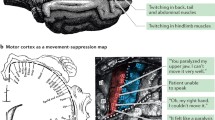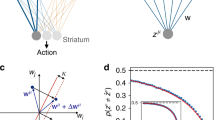Abstract
The rapid development of neurosciences in the past two decades has led to the emergence of new experimentally based facts and increased the number of hypotheses on the implementation of motor and cognitive brain functions. The purpose of the review is to present the most important part of this new material; this should be taken into consideration in planning and conducting both fundamental and applied research on brain functions.
Similar content being viewed by others
REFERENCES
Marconi, B., Genovesio, A., Battaglia-Mayer, A., et al., Eye-hand coordination during reaching. I. Anatomical relationships between parietal and frontal cortex, Cereb. Cortex, 2001, vol. 11, no. 6, p. 513.
Fleming, J.F. and Crosby, E.C., The parietal lobe as an additional motor area; the motor effects of electrical stimulation and ablation of cortical areas 5 and 7 in monkeys, J. Comp. Neurol., 1955, vol. 103, no. 3, p. 485.
Mountcastle, V.B., Lynch, J.C., Georgopoulos, A., et al., Posterior parietal association cortex of the monkey: command functions for operations within extrapersonal space, J. Neurophysiol., 1975, vol. 38, no. 4, p. 871.
Rathelot, J.A., Dum, R.P., and Strick, P.L., Posterior parietal cortex contains a command apparatus for hand movements, Proc. Natl. Acad. Sci. U.S.A., 2017, vol. 14, no. 16, p. 4255.
Gardner, E.P., Neural pathways for cognitive command and control of hand movements, Proc. Natl. Acad. Sci. U.S.A., 2017, vol. 114, no. 16, p. 4048.
Mazurek, K.A. and Schieber, M.H., Injecting instructions into premotor cortex, Neuron, 2017, vol. 96, no. 6, p. 1282.
Lebedev, M.A. and Ossadtchi, A., Commentary: injecting instructions into premotor cortex, Front. Cell. Neurosci., 2018, vol. 12, p. 65.
Bouton, C.E., Shaikhouni, A., Annetta, N.V., et al., Restoring cortical control of functional movement in a human with quadriplegia, Nature, 2016, vol. 533, no. 7602, p. 247.
Capogrosso, M., Milekovic, T., Borton, D., et al., A brain-spine interface alleviating gait deficits after spinal cord injury in primates, Nature, 2016, vol. 539, no. 7628, p. 284.
Middleton, F.A. and Strick, P.L., Basal ganglia and cerebellar loops: motor and cognitive circuits, Brain Res. Rev., 2000, vol. 31, no. 2–3, p. 236.
Dum, R.P. and Strick, P.L., Transneuronal tracing with neurotropic viruses reveals network macroarchitecture, Cur. Opin. Neurobiol., 2013, vol. 23, no. 2, p. 245.
Bostan, A.C., Dum, R.P., and Strick, P.L., The basal ganglia communicate with the cerebellum, Proc. Natl. Acad. Sci. U.S.A., 2010, vol. 107, no. 18, p. 8452.
Hoshi, E., Tremblay, L., Féger, J., et al., The cerebellum communicates with the basal ganglia, Nat. Neurosci., 2005, vol. 8, no. 11, p. 1491.
Bostan, A.C. and Strick, P.L., The cerebellum and basal ganglia are interconnected, Neuropsychol. Rev., 2010, vol. 20, no. 3, p. 261.
Strick, P.L., Dum, R.P., and Fiez, J.A., Cerebellum and nonmotor function, Ann. Rev. Neurosci., 2009, vol. 32, p. 413.
Hamani, C., Saint-Cyr, J. A., Fraser, J., et al., The subthalamic nucleus in the context of movement disorders, Brain, 2004, vol. 127, no. 1, p. 4.
Bostan, A.C. and Strick, P.L., The basal ganglia and the cerebellum: nodes in an integrated network, Nat. Rev. Neurosci., 2018, vol. 19, no. 6, p. 338.
Pelzer, E.A., Hintzen, A., Goldau, M., et al., Cerebellar networks with basal ganglia: feasibility for tracking cerebello-pallidal and subthalamo-cerebellar projections in the human brain, Eur. J. Neurosci., 2013, vol. 38, no. 8, p. 3106.
Wedeen, V.J., Hagmann, P., Tseng, W., et al., Mapping complex tissue architecture with diffusion spectrum magnetic resonance imaging, Magn. Reson. Med., 2005, vol. 54, no. 6, p. 1377.
Caligiore, D., Pezzulo, G., Baldassarre, G., et al., Consensus paper: towards a systems-level view of cerebellar function: the interplay between cerebellum, basal ganglia, and cortex, Cerebellum, 2017, vol. 16, no. 1, p. 203.
Bostan A.C., Strick P.L. Cerebellar connections with the cerebral cortex and the basal ganglia. In: Caligiore D., Pezzulo G., Baldassarre G. et al. Consensus paper: towards a systems-level view of cerebellar function: the interplay between cerebellum, basal ganglia, and cortex // Cerebellum. 2017. V. 16. № 1. P. 205.
Verschure P.F.M.J., Zucca R., Herreros I. Regulating the recruitment of the cerebellum via the nucleo-olivary inhibition. In: Ibid. P. 207.
Jörntell H. Spinocerebellar circuitry—consequences for the organization of neocortical motor control. In: Ibid. P. 209.
Houk J. The DPM architecture for learning and control. In: Ibid. P. 210.
Doya K. Cerebellum and basal ganglia work together for model-based actions. In: Ibid. P. 212.
Miall R.C. A systems-level view of cerebellar motor and cognitive function. In: Ibid. P. 214.
Lago-Rodriguez A., Galea J.M. What have we learnt from non-invasive brain stimulation studies regarding the role of the cerebellum and its interactions with other brain regions in motor control and learning? In: Ibid. P. 215.
Popa T., Kishore A. Cerebellar modulation of cortical plasticity in basal ganglia-related movement disorders. In: Ibid. P. 216.
Caligiore D., Helmich R.C., Dirkx M., Baldassarre G. The basal ganglia-cortical-cerebellar network in Parkinson’s resting tremor. In: Ibid. P. 219.
Caligiore D., Arbib M.A., Miall R.C., and Baldas-sarre G., The super-learning hypothesis: integrating learning processes across cortex, cerebellum and basal ganglia, Neurosci. Biobehav. Rev., 2019, vol. 100, p. 19.
Doya, K., What are the computations of the cerebellum, the basal ganglia and the cerebral cortex? Neural Network, 1999, vol. 12, nos. 7–8, p. 961.
Doya, K., Complementary roles of basal ganglia and cerebellum in learning and motor control, Cur. Opin. Neurobiol., 2000, vol. 10, no. 6, p. 732.
Brito, C.S.N. and Gerstner, W., Nonlinear Hebbian learning as a unifying principle in receptive field formation, PLoS Comput. Biol., 2016, vol. 12, no. 9, p. e1 005 070.
Ngezahayo, A., Schachner, M., and Artola, A., Synaptic activity modulates the induction of bidirectional synaptic changes in adult mouse hippocampus, J. Neurosci., 2000, vol. 20, no. 7, p. 2451.
Knudsen, E.I., Supervised learning in the brain, J. Neurosci., 1994, vol. 14, no. 7, p. 3985.
Niv, Y., Reinforcement learning in the brain, J. Math. Psychol., 2009, vol. 53, no. 3, p. 139.
Miall, R.C. and Galea, J., Cerebellar damage limits reinforcement learning, Brain, 2016, vol. 139, no. 1, p. 4.
Doya, K., Metalearning and neuromodulation, Neural Network, 2002, vol. 15, nos. 4–6, p. 495.
Schweighofer, N., Doya, K., and Layc, F., Unsupervised learning of granule cell sparse codes enhances cerebellar adaptive control, Neuroscience, 2001, vol. 103, no. 1, p. 35.
Fischer, A.G. and Ullsperger, M., An update on the role of serotonin and its interplay with dopamine for reward, Front. Hum. Neurosci., 2017, vol. 11, p. 484.
Schweighofer, N., Doya, K., and Kuroda, S., Cerebellar aminergic neuromodulation: towards a functional understanding, Brain Res. Rev., 2004, vol. 44, no. 2–3, p. 103.
Fonollosa, J., Neftci, E., and Rabinovich, M., Learning of chunking sequences in cognition and behavior, PLoS Comput. Biol., 2015, vol. 11, no. 11, p. e1 004 592.
Gurney, K., Prescott, T.J., and Redgrave, P., A computational model of action selection in the basal ganglia. I. A new functional anatomy, Biol. Cybern., 2001, vol. 84, no. 6, p. 401.
Doyon, J., Penhune, V., and Ungerleider, L.G., Distinct contribution of the cortico-striatal and cortico-cerebellar systems to motor skill learning, Neuropsychologia, 2003, vol. 41, no. 3, p. 252.
Wolpert, D.M., Diedrichsen, J., and Flanagan, J.R., Principles of sensorimotor learning, Nat. Rev. Neuro-sci., 2011, vol. 12, no. 12, p. 739.
Dudman, J.T. and Krakauer, J.W., The basal ganglia: from motor commands to the control of vigor, Curr. Opin. Neurobiol., 2016, vol. 37, p. 158.
Thorp, E.B., Kording, K.P., and Mussa-Ivaldi, F.A., Using noise to shape motor learning, J. Neurophysiol., 2017, vol. 117, no. 2, p. 728.
Seidler, R.D., Noll, D.C., and Chintalapati, P., Bilateral basal ganglia activation associated with sensorimotor adaptation, Exp. Brain Res., 2006, vol. 175, no. 3, p. 544.
Shadmehr, R. and Holcomb, H.H., Neural correlates of motor memory consolidation, Science, 1997, vol. 277, no. 5327, p. 821.
Mathis, M.W., Mathis, A., and Uchida, N., Somatosensory cortex plays an essential role in forelimb motor adaptation in mice, Neuron, 2017, vol. 93, no. 6, p. 1493.
Wagner, M.J., Kim, T.H., Savall, J., et al., Cerebellar granule cells encode the expectation of reward, Nature, 2017, vol. 544, no. 7648, p. 96.
Galea, J.M., Mallia, E., Rothwell, J., and Diedrichsen, J., The dissociable effects of punishment and reward on motor learning, Nat. Neurosci., 2015, vol. 18, no. 4, p. 597.
Funding
This study was supported as a part of Basic Research Project no. 63.1 of the Russian Academy of Sciences.
Author information
Authors and Affiliations
Corresponding authors
Ethics declarations
The authors declare that they have no conflict of interest.
Additional information
Translated by A. Khaitin
Rights and permissions
About this article
Cite this article
Badakva, A.M., Miller, N.V. & Zobova, L.N. New Concepts on the Implementation of Motor and Cognitive Functions in the Brain: Facts and Hypotheses. Hum Physiol 46, 343–350 (2020). https://doi.org/10.1134/S0362119720030020
Received:
Revised:
Accepted:
Published:
Issue Date:
DOI: https://doi.org/10.1134/S0362119720030020




